Loading
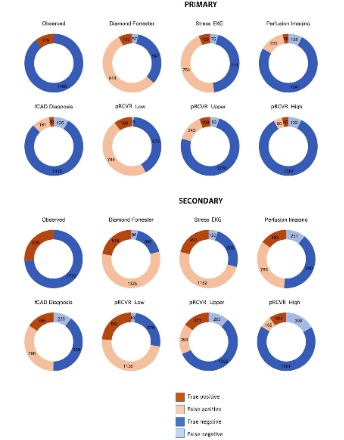
2025
Volume 6, Issue 2, p76-147
Articles published in this issue are Open Access and licensed under Creative Commons Attribution License (CC BY NC) where the readers can reuse, download, distribute the article in whole or part by mentioning proper credits to the authors.
Ticagrelor-Associated Central Sleep Apnea: A Case Report and Review of the Literature
Danny Sameh Darwich, Sagger Mawri
Ticagrelor is an oral, third-generation reversible P2Y12 receptor antagonist used in the treatment of patients with atherosclerotic cardiovascular disease. Dyspnea is a well-recognized side effect of ticagrelor, typically occurring within hours to days after initiation. In most cases, the dyspnea is mild and resolves spontaneously without intervention. However, dyspnea can be significant and intolerable in some patients necessitating discontinuation of ticagrelor.
J Clin Cardiol, 2025, Volume 6, Issue 2, p76-83 | DOI: 10.33696/cardiology.6.074
CT Coronary Angiography Vs Cardiac Catheterization and Risk of Acute Kidney Injury – Comparative Study
Swatam Jain, Farzad Majidi
CT coronary angiography (CTCA) and invasive coronary angiography (ICA) are widely used to evaluate coronary artery disease (CAD). Both involve iodinated contrast, which may cause contrast-induced acute kidney injury (CI-AKI), particularly in high-risk patients. This study compared the incidence of AKI following CTCA versus ICA in hospitalized patients with symptomatic CAD.
J Clin Cardiol, 2025, Volume 6, Issue 2, p84-90 | DOI: 10.33696/cardiology.6.075
- Abstract |
- Full Text |
- Cite |
- Supplementary File
Coronary CT Angiography and Assessment of Coronary In-Stent Restenosis—A Brief Report of Stent-Related Factors among Positive Angiographic Cases
Ramin Khameneh Bagheri, Mahdi Radfar, Hassan Mehrad-Majd, Ali Heydari Bakavoli
In-stent restenosis (ISR) remains a significant concern in coronary artery disease management. This study aims to evaluate the efficacy of coronary computed tomography angiography (CCTA) in detecting ISR and to identify stent-related factors in a real-world patient population.
J Clin Cardiol, 2025, Volume 6, Issue 2, p91-96 | DOI: 10.33696/cardiology.6.076
In-hospital Mortality Trends Across the Pre-pandemic, Pandemic, and Post-pandemic Eras in Cardiovascular and Cerebrovascular Conditions: A Retrospective Cohort Study
Swatam Jain, Pinak Shah, Alfred Danielian, Boone Singtong, Christopher Aboujaoude, Zade Zahlan, Rakahn Haddadin, Kush Kapadia
The COVID-19 pandemic strained healthcare delivery, but its lasting impact on acute and chronic cardiovascular and cerebrovascular mortality remains unclear. We compared in-hospital mortality for ST-elevation myocardial infarction (STEMI), non-ST-elevation myocardial infarction (NSTEMI), ischemic stroke, and congestive heart failure (CHF) across pre-pandemic, pandemic, and post-pandemic eras.
J Clin Cardiol, 2025, Volume 6, Issue 2, p97-102 | DOI: 10.33696/cardiology.6.077
- Abstract |
- Full Text |
- Cite |
- Supplementary File
Utilization of Prognostic Protein Tests in the Investigation of Suspected Chronic Coronary Artery Disease
Stephen A Williams, Jessica Chadwick, David Astling, Michael Hinterberg, Rachel Ostroff, Klara Rumora, Medina Durmo, Joan E Walter, Christian Mueller
Guidelines-driven diagnostic investigations for suspicion of functionally relevant coronary artery disease (fCAD) are complex and expensive. Therefore, we evaluated whether a previously validated proteomic residual cardiovascular risk (RCVR) model could complement existing fCAD detection strategies by accurately identifying patients at high risk for an event and safely ruling out fCAD in low-risk patients.
J Clin Cardiol, 2025, Volume 6, Issue 2, p103-113 | DOI: 10.33696/cardiology.6.078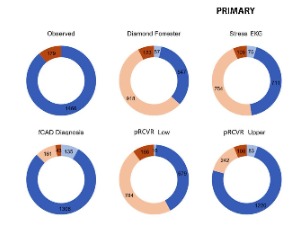
- Abstract |
- Full Text |
- Cite |
- Supplementary File
Recurrent Prosthetic Valve Endocarditis Causing Pseudoaneurysm of the Mitral-aortic Intervalvular Fibrosa
Kenney Abraham, Matthew Pelletier, Ryan Heslin
Infective endocarditis (IE) refers to inflammation of the endocardium, which is the inner layer of the heart. One of the most significant risk factors for developing IE is bioprosthetic valves within the heart. IE can lead to formation of vegetations on the surfaces of heart valves, making treatment difficult with antibiotics alone, often requiring surgery.
J Clin Cardiol, 2025, Volume 6, Issue 2, p114-118 | DOI: 10.33696/cardiology.6.079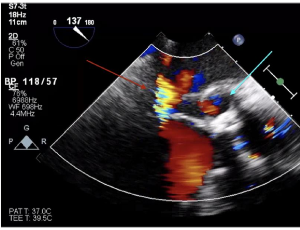
Optimizing Stroke Prevention after AtriClip Left Atrial Appendage Occlusion: A Narrative Review of Anticoagulation Dilemmas and Imaging Needs
Swatam Jain, Alfred Danielian, Pinak Shah, Roxanne Moghadam
Atrial fibrillation (AF) is a major risk factor for ischemic stroke, with the left atrial appendage (LAA) being the predominant source of thrombi. Surgical LAA occlusion (LAAO) with devices like the AtriClip offers a mechanical alternative to long-term oral anticoagulation (OAC), particularly for patients at high bleeding risk or with OAC contraindications.
J Clin Cardiol, 2025, Volume 6, Issue 2, p119-124 | DOI: 10.33696/cardiology.6.080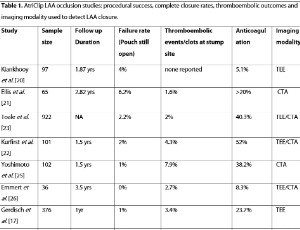
- Abstract |
- Full Text |
- Cite |
- Supplementary File
Allopurinol for Prevention of Contrast-Induced Acute Kidney Injury in Patients Undergoing Percutaneous Coronary Intervention: A Randomized-Controlled Trial
Kareem Mahmoud, Wadhah Hasan, Hesham Taha, Dalia ElRemisy
Contrast-induced acute kidney injury (CI-AKI) is a potential complication following percutaneous coronary intervention (PCI), particularly in patients with pre-existing kidney conditions. Previous research has identified hyperuricemia as a predictor for CI-AKI. Allopurinol, a medication commonly used to manage hyperuricemia, also possesses anti-inflammatory properties. This study aims to assess the impact of adding allopurinol to hydration therapy on CI-AKI incidence in patients undergoing PCI.
J Clin Cardiol, 2025, Volume 6, Issue 2, p133-141 | DOI: 10.33696/cardiology.6.082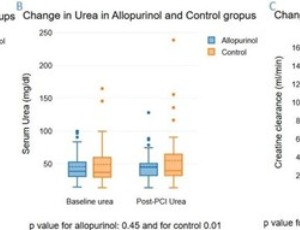
Association of Vitamin D Serum Levels with Clinical Outcomes in Patients with Acute Decompensated Heart Failure
Seyedeh Fatemeh Mirrazeghi, Parsa Monajemi, Soheil Hassanipour, Yasaman Borghei, Samira Arami
Heart failure (HF) stands out as a major reason for hospital admissions. Vitamin D deficiency is also associated with a higher risk of cardiovascular diseases. Due to recent conflicting findings, this study aimed to investigate clinical outcomes based on serum vitamin D levels in hospitalized patients with HF.
J Clin Cardiol, 2025, Volume 6, Issue 2, p142-147 | DOI: 10.33696/cardiology.6.083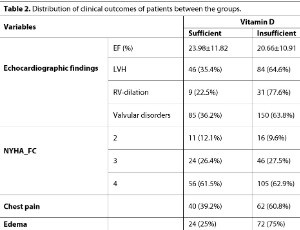
Recommended Articles
Chest Pain in Repeated Emergency Department Visitors
Chest pain is the leading symptom in 5 to 8% of all emergency department (ED) visits and is also one of the major reasons of repeated ED visits, causing around 6% of these cases [1]. Generally, in 15 to 25% of patients with chest pain, acute myocardial infarction (AMI) is the underlying cause.
Lipoprotein Apheresis: First FDA Indicated Treatment for Elevated Lipoprotein(a)
Lipoprotein(a) [Lp(a)] is a genetically determined lowdensity lipoprotein (LDL) particle that is comprised of apolipoprotein(a) [apo(a)] and apolipoprotein B-100 (apoB) moieties. It is well-established that elevated Lp(a) is an independent risk factor for cardiovascular disease (CVD).
Paradoxical Low Flow Aortic Stenosis: A Clinical Dilemma
Internists as well as cardiologists often receive echocardiogram reports which failed to offer a clear definition of the aortic stenosis (AS) severity due to discordant data regarding the aortic valve gradients and the valve area. Sometimes AS appears severe according to the valve area criteria, in spite of the fact that gradients across the valve are not in the severe range.
Acute Success and Long-term Follow-up of Catheter Ablation of Isthmus-dependent Atrial Flutter; A Comparison of 10 mm Tip Standard, 6 mm Tip Irrigated Radiofrequency, and Cryotherapy Catheters
Various catheter ablation technologies have evolved to improve the procedural success and safety of cavotricuspid isthmus (CTI) block. Numerous studies have compared the different energy types, catheter tip sizes, and energy settings.
A View on the Contribution of Hedgehog Signalling to Ventricular Septal Development
The ventricular septal defect (VSD) is the most frequent congenital heart disease in humans. It is defined as an opening in the septum separating the left and the right ventricle. This gap results in a mixture of oxygenated and deoxygenated blood and in an enhanced blood flow towards the lung and the left ventricle, a condition that leads to severe diseases such as left ventricular hypertrophy as well as pulmonary edema and dilatation.
Hypertrophic Cardiomyopathy and the Troponins: The Enigma Remains
Hypertrophic cardiomyopathy (HCM) is a heart muscle disorder and is the most common form of Mendelianinherited heart disease, affecting approximately 0.2% of the global population. In adults the disease is often inherited as an autosomal dominant trait caused by mutations, mainly in one of the 23 cardiac sarcomere protein genes.
Body Mass Index and Treatment Response in Patients with Cardiac Light-Chain Amyloidosis
Elevated body mass index (BMI) has been associated with an increased risk of cancer and has been shown to have a negative impact on survival in patients with breast, prostate, oral cancer, and leukemia. In plasma cell dyscrasias, obesity has not only been shown to be a risk factor for the development of multiple myeloma, but also has been associated with a higher rate of progression from monoclonal gammopathy of unknown significance (MGUS) to multiple myeloma, and if intervened on, has bee
Mono- and Multi-nucleated Cardiomyocytes Do Not Constitute Transcriptionally Distinct Entities
The last years have witnessed an increased interest in the genetic, epigenetic and transcriptional heterogeneity of mammalian hearts under basal and disease conditions. Although it is known for a long time that the heart consists of several, functionally different cell populations, more detailed insights into the potential heterogeneity of individual cell populations, such as cardiomyocytes, endothelial cells or fibroblasts were hindered by the lack of appropriate techniques.
Commentary on: Structural Basis of the Activation of Heterotrimeric Gs-Protein by Isoproterenol-Bound Beta 1- Adrenergic Receptor
G protein coupled receptors (GPCRs) comprise a large superfamily of transmembrane proteins containing more than 800 unique family members. Critically, GPCRs mediate most of the cell responses to extracellular stimuli including hormones, neurotransmitters, light, taste, etc.
Predicting COVID-19 Hospitalized Patients’ Outcome with Homocysteine
The COVID-19 pandemic has provoked a global, rapid increase of cases due to the high infectivity of the etiological agent, COVID-19 virus. In February 2021, over 110 million confirmed COVID-19 cases with 1 million deaths were reported worldwide (www.who.int).
Beneficial Effects of Surgical Closure of Atrial Septal Defect Outweigh Potential Complications in Sick Infants
Atrial septal defect (ASD) is a common congenital heart disease diagnosed during childhood. Persistently increased pulmonary blood flow and dilated right atrium (RA) and right ventricle (RV) result in multiple symptoms and morbidities in adulthood; untreated adults may develop exercise intolerance, congestive heart failure, atrial tachyarrhythmias, pulmonary hypertension (PH), embolic stroke, or even death.
Cardiac Stem Cell Therapy, Quo Vadis
Cardiovascular disease causes 30% of global mortality and is still the number one cause of death worldwide. A main patho-physiological process is the coronary disease leading to malperfusion and ischemic cardiac disease as well as cardiac infarction.
Percutaneous Treatment of Mitral Valve Regurgitation: An Evolving Field
In the past two decades great interest has developed for less-invasive, percutaneous mitral valve (MV) repair strategies. This is mainly due to the increasing number of elderly patients with comorbidities and/or patients with left ventricular (LV) dysfunction, that are associated with a high surgical risk.
Blood Pressure Lowering May Decrease Cognitive Decline; But Are We Ready to Lower Blood Pressure in the Real World?
Dementia and hypertension are highly prevalent, epidemiologically related chronic conditions disproportionately affecting older persons; approximately 97% of persons with dementia and 66% with hypertension are over the age of 65.
The Value of the Left Atrial Appendage Orifice Perimeter of 3D Model Based on 3D TEE Data in the Choice of Device Size of LAmbre™ Occluder
Preoperative optimal selection of the occluder size is crucial in percutaneous left atrial appendage (LAA) occlusion, and the maximal width of the LAA orifice is the main reference index, however it cannot fully meet the practical operation requirements. We retrospectively analyzed three-dimensional (3D) transesophageal echocardiography (TEE) and computed tomography (CT) imaging dataset of the 41 patients who underwent LAA occlusion with LAmbre™ system.
Preparing for a More Public Health-Aware Practice of Medicine in Response to COVID-19
After one year in a pandemic, we mourn the loss of over half a million lives in the United States, and over four million worldwide, and remain concerned over the challenges facing the families of 35 million people in the United States, and 200 million worldwide, who have suffered from cases of COVID-19.
Insights of CECCY Trial: Should Troponin be the Target for Anthracycline Cardiotoxicity Prevention?
Advances in oncology such as better access to health care system, earlier cancer diagnosis and new chemotherapies have led to longer survival of oncologic patients over the last decades. However, this population is vulnerable to cardiovascular drug-related adverse events like cardiomyopathy, which leads to heart failure and impairs survival and quality of life.
Asystole during Tilt Testing-Induced Syncope: A Long-Term Follow-Up
The vasovagal (VV) syncope, a variant of neurally mediated reflex syncopal syndromes is a common clinical entity and is one of a heterogeneous group of disorders of orthostatic intolerance that can be identified during an upright tilt table (TT) test. The clinical response to this test is varied, with a majority of the patients exhibiting a mixed response (vasodepressor-cardioinhibitory) and the remainder either a vasodepressor or cardioinhibitory predominant response depending on the relative d
Thyroid Hormones in Dilated Cardiomyopathy: Is It a Promising Therapeutic Option?
Dilated cardiomyopathy (DCM) is chronic heart muscle disease characterized by progressive ventricular enlargement and contractile dysfunction involving either left or both ventricles. It is considered one of the leading causes of heart failure with reduced ejection fraction (HFrEF) worldwide
Bromodomain and Extra-Terminal Family Protein Inhibitors: A Potentially New Therapy for Heart Disease
Bromodomain-containing protein 4 (BRD4) is a member of the mammalian bromo- and extra-terminal domain (BET) protein family, which also comprises BRD2, BRD3, and testis-specific BRDt.
